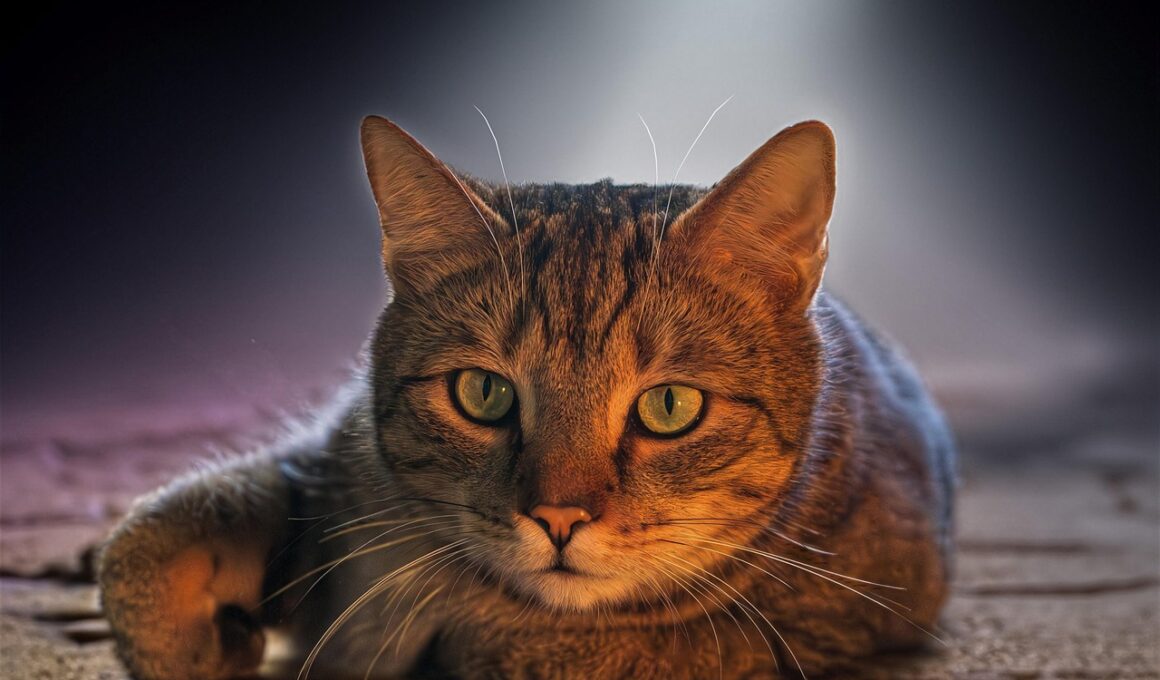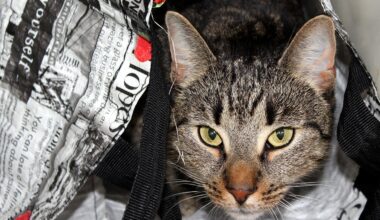The Role of Lighting Angles in Cat Portraiture
Understanding lighting angles is crucial for capturing stunning cat portraits that showcase the feline’s features effectively. Light can enhance or diminish the aesthetic appeal of a photograph, depending on its angle and intensity. Using natural light can create a soft, diffused effect, particularly during the golden hour, which greatly influences the mood of the photo. Positioning the light source to the side can create interesting shadows that sculpt the cat’s face and improve dimensionality. Experimenting with low angles can provide a unique perspective, where the light illuminates the subject dramatically from below. This approach works remarkably well to exhibit the catchlight in your cat’s eyes, adding depth and liveliness to the image. Additionally, consider how colored lighting might enhance the mood, such as using warm tones to evoke coziness or cooler shades to express tranquility. Lastly, remember to monitor your cat’s reactions to light sources; abruptly strong light can be unsettling. With understanding and patience, mastering lighting angles can lead to mesmerizing cat portraits that capture their true essence.
In cat photography, shadows play a vital role that can enhance your portraits significantly. Soft shadows created by diffused natural light often add depth and texture without being overwhelmingly harsh. On the other hand, strong shadows resulting from direct sunlight can either be undesirable or effectively used to create contrast. The key is to evaluate the light source’s direction and intensity carefully; this will allow you to manipulate how shadows interact with your cat’s features. An ideal way to achieve greater control over shadows is to utilize reflectors, which can bounce light back onto your subject, softening the shadows. Some photographers even use artificial lighting setups that come equipped with softboxes or diffusers to achieve smooth illumination. Additionally, you may choose to experiment with backlighting to create silhouettes or unique effects, where the light outlines your cat as they explore. Whichever method you select, the goal is to find a balance that enhances the portrait while remaining true to the character of your feline model. Playing with shadows will yield fascinating results that can elevate your cat photography skills to new heights.
Choosing the Right Time and Place
Timing and location are essential factors when photographing cats, as they greatly influence the quality of light. The best time for outdoor cat photography is generally early in the morning or late afternoon. This is when the sunlight is softer and more flattering, producing a warm glow that enhances fur colors and textures. Clouds can also act as natural diffusers, providing even lighting that reduces harsh shadows. Locations with natural backdrops, such as gardens or sunlit rooms, can create intriguing aesthetics in your portraits. Inside the home, positioning your cat near windows allows you to make use of natural light while capturing the relaxed state of your pet. Pay attention to the direction of the light; cats typically seek out sunny spots for their lounging. If shooting indoors, try to schedule sessions when sunlight streams through, making for beautiful, illuminated shots. Be sure to keep distractions at bay, as a calm environment helps encourage your cat to pose naturally. Ultimately, discovering the ideal time and place for your shoots plays a significant role in your cat portraiture success.
Understanding the concept of “Golden Hour” is pivotal in enhancing your cat photography. This period occurs just after sunrise and before sunset, resulting in warm, soft tones that improve overall image quality. The gentle light during this time avoids the harshness experienced during midday photography, providing a flattering glow on your cat’s coat. Additionally, golden hour light minimizes unflattering shadows on the face while creating mesmerizing highlights that add character to the frame. You can capture the sun casting a beautiful halo around your cat’s ears, enhancing the portrait’s overall appeal. By planning your photography sessions to coincide with golden hours, you maximize the potential of natural light. This technique can effectively highlight features that characterize your feline subject, like shiny whiskers or vivid eye colors, drawing the viewer’s attention. Do not hesitate to adjust your camera settings during this golden hour, as light fluctuates significantly. Aim for a wider aperture to further emphasize your cat against the soft backgrounds resulting from beautiful colors. Practicing during this pivotal time can elevate your cat portraiture to stunning new levels.
Utilizing Artificial Lights
In scenarios where natural light is insufficient, turning to artificial lighting is a viable alternative for cat photography. When using external flashes, softboxes, or continuous lights, the most crucial aspect is to handle the light source gently to minimize startling your feline model. A softbox, for instance, can diffuse direct light, creating a flattering and evenly lit portrait that enhances fur details while retaining a natural look. Remember, it’s essential to avoid harsh lights that can cast unflattering shadows on your cat’s face. Experimenting with reflectors can help redirect light to illuminate the subject softly. Position the light source slightly above your cat and to the side for an artistic touch, highlighting your pet’s facial structure beautifully. Additionally, consider using colored gels on your artificial lights to experiment with moods and styles, creating playful and expressive portraits that stand out. With the right approach, artificial lighting can become an ally in your cat photography toolkit. It grows your creative options, ensuring captivating portraits regardless of the natural conditions available.
Understanding how to manage reflections is essential for successful cat portraiture, especially when shooting in glossy or shiny environments. For instance, windows can either beautifully play up your highlight textures or introduce disruptive glare that ruins the photo. To avoid reflection issues, ensure your light source is not directly facing reflective surfaces. If you notice undesirable reflections appearing in the frame, change your angle slightly to eliminate them. Another technique is to use diffusion materials to soften the light, making it less intense while achieving a pleasant look. Utilizing simple items like cheesecloth can help achieve this effect effectively. It’s vital to pay close attention to your cat’s eyes, as their primary allure often derives from captivating reflections. Capturing sharp reflections in their eyes helps draw viewers to the image, showcasing their vibrancy and personality. Always be patient, as it might take a few tries to find the perfect angle that eliminates obtrusive reflections while highlighting your cat’s gaze. Taking the time to restore clarity to your images enhances the overall quality significantly in your cat portraiture.
Final Tips for Successful Cat Lighting
In summary, mastering lighting techniques is crucial for creating outstanding cat portraits. From the angle of the light to the timing, each element contributes to the final image that showcases your feline’s true personality. Don’t hesitate to experiment with various light sources, both natural and artificial, to determine what works best for different scenarios. Continuously observe how light affects color and texture, and use that knowledge to elevate your photography skills. Remember, patience is key; allow your cat to settle and become comfortable in their environment before snapping pictures. Lastly, post-processing can enhance your final images further, helping you adjust lighting imperfections discovered during the shoot. Investing time into these simple techniques can profoundly affect your final cat portraits, resulting in captivating images that beautifully tell the story of your pet. Mastering these aspects will ensure that each portrait reflects not just a moment but a personality. As you continue honing your skills and experimenting, your ability to capture stunning cat portraits will grow, ensuring that each photograph is a true celebration of your feline friend.


